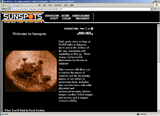Sunspots
This lesson covers solar science, ancient and modern, features an interactive research exercise in which students attempt to correlate the areas of sunspots with those of x-ray active regions. Self-guided sections on history and modern study include researcher interviews.
Key Questions
1. How have humans studied and gained and understanding of sunspots throughout their history?
2. What do we currently know about sunspots and their effects on Earth?
3. Do visible sunspots seen on the solar disk correlate with areas of active regions seen in X-ray images of the sun?
Learning Objectives
1. Students will learn about the importance of solar observations in ancient cultures and how solar science changed with the advent of telescopes.
2. Students will know how to view the Sun safely using a simple projector, or with or without a telescope.
3. Students will be able to discuss some of the main currents of modern solar research.
4. Students will be able to conduct comparisons of X-ray active regions and sunspots in the Yohkoh images supplied.
5. Students will be able to make a case for correlation or lack of correlation between the X-ray active regions and sunspots in the Yohkoh images supplied.
General Subject Areas
Astronomy, Solar Syste
|
 Author: Noel Wanner, Jim Spadaccini, Igor Ruderman, Anne Miller-Bagwell
Author: Noel Wanner, Jim Spadaccini, Igor Ruderman, Anne Miller-Bagwell
VIEW THE LESSON
Student Activities
Students use the web site in self-guided exploration of the history of solar science (4 pages), and the advances of modern research (7 pages). In the Activity section, they use a Java program (applet) to compare sunspots and x-ray images of the sun. This research activity introduces the concept of correlation and teaches measurement, graphing, and critical thinking. Worksheets are provided for students to make plots of the areas against time as well.
Student Prerequisites
Ability to use a web browser, plot points and make graphs. Some familiarity with the concepts of electric current, induction, and convection.
Assessment
Students may present their research results and compare them to those of other teams or students. Worksheets may be done as jigsaw activities. Class collaboration and discussion may be used to rank teams.
Sunspots test pdf html
Answer key pdf html
Worksheets
-Dawn of Sun Science
pdf html
Answer Key pdf html
-Researcher Qualifications
pdf html
Answer Key pdf html
-Solar Research Proposal
pdf html
-Research Data Log
pdf html
Graphing Sheets
-X-ray vs. Sunspot area
pdf html
-Sunspot area vs. date
pdf html
Sample Graph pdf html
-X-ray area vs. date
pdf html
Sample Graph pdf htm
Extended Learning
N/A
|
View Teacher Feedback
Send Us Your Feedback
Time Requirements
1-2 hours instructor preparation time; 2-3 class periods to cover self- guided sections on History and Modern Research; 1-2 class periods to conduct research activity and study /analyze results. 1 class period to report, collect, and discuss results for entire class. Additional time may be needed to prepare reports.
Materials Required
-Internet connected computer with WWW browser program
-Student worksheets
Required Plugins
-Java
-RealPlayer
-QuickTime
Additional Resources
N/A
Best For Grades
high school
National Science Education Standards (NSES)
grades 5-8
grades 9-12
State Science Standards
Grade 5 Earth Sciences
Grade 6 Heat, Energy in Earth System, and Resources
Grade 8 Physical Science
Grades 9-12 Earth Sciences
Have a science question? Visit our Ask an Expert page. Email questions or comments about SEGway resources to: outreach@ssl.berkeley.edu
|












